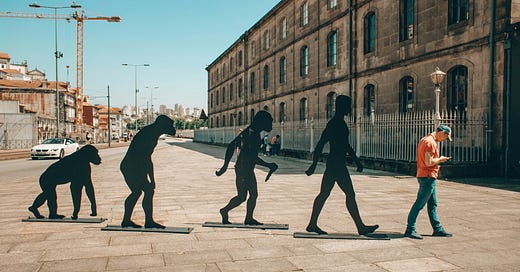
Some argue that in the fast-paced and competitive world of hedge fund management, adaptability is paramount. Strategies must constantly evolve to maintain their edge. It’s a matter of survival of the fittest; nothing lasts forever, and markets are ever-changing. Others, however, focus on crafting strategies that can withstand the many tests of time. They subscribe to the Lindy effect, which suggests that the longer a strategy has survived, the longer its remaining life expectancy. Yet, fate had a different script: Lindy's, a New York deli stalwart since 1921, shuttered its doors for good in 2017.
Does this mean that constant change is the only way to survive?
At Takahē Capital, we often refer to our logo when it comes to robustness and resilience. The South Island Takahē, a majestic flightless bird indigenous to New Zealand, faced the brink of extinction in 1898, only to be rediscovered half a century later in 1948. This resilient creature symbolizes endurance and survival, embodying nature's ability to defy the odds and thrive against adversity. Meanwhile, another bird, the Aldabra rail, a humble bird native to the Indian Ocean, faced a similar struggle for survival. Submerged beneath the waves for millennia, the Aldabra atoll witnessed the extinction of its flightless rail subspecies. However, through a remarkable process of iterative evolution, the Aldabra rail reemerged, adapting to its environment and thriving once again as a flightless bird.
It turns out there is more to these stories.
For Lindy's delicatessen in NYC, a mere 1.5-star rating out of 5 on Yelp, wasn’t exactly a good omen for a bright future. Similarly, many flightless birds went extinct over time due to the introduction of new natural enemies or changes in their environment. The surprising insight from these examples is not that one should stick to a failing system and expect different results if tried again. Rather, it’s about the speed of innovation and the impact that small adaptations can make.
Adapt, improvise, overcome
The Takahē didn’t simply survive because they’re extremely stoic or were saved by humans. Conservation efforts only launched after nearly 50 years of the bird being presumed extinct. To avoid predators, the Takahē migrated to the wild, alpine habitat, which is less than ideal but offered increased chances of survival. The rugged area was relatively isolated from the main threats to the Takahē: humans, deer, and introduced predators.
In the case of the Aldabra rail, iterative evolution resulted in the species evolving flightlessness twice. While the amount of time it took for this to happen (around 20,000 years) might not be considered rapid innovation in trading, it’s incredibly quick on nature’s scale. However, the more relevant part is why these birds ended up on the same atoll twice: the Aldabra rail is a subspecies of the white-throated rail, which is a “persistent colonizer.” These birds build up on large land bodies and depart en masse once their habitat becomes overcrowded, migrating to new places, looking for an evolutionary opportunity.
Persistent colonizers with core principles
Trend Following, much like the Takahē and the Aldabra rail, has undergone significant changes over time. The evolution of Trend Following reflects a constant process of adaptation to changing market dynamics. From its origins in the 1970s to the present day, Trend Following has evolved incrementally, incorporating advancements in risk management, portfolio construction, and diversification strategies. Technological progress has greatly influenced infrastructure, execution, and market access.
The current evolutionary trends for Trend Following are diverse, showcasing a spectrum of approaches. Some focus on top-down CTA index replication applying regression techniques to a small group of markets, exemplified by Andrew Beer's iMGP DBi Managed Futures Strategy ETF. Others provide efficient access to established, classic trend following strategies that trade a lot of markets, as seen in Jerry Parker's Blueprint Chesapeake Multi-Asset Trend ETF. Additionally, there's a growing interest in exploring non-conventional and uncorrelated markets, as evidenced by Takahē Capital's spread momentum program. Overall, the trajectory of Trend Following’s ongoing exploration of new markets and strategies parallels the behavior of the persistent colonizer in nature.
However, Trend Following, just like successful evolutionary strategies, has always been based around some core concepts to avoid total extinction and ensure the longevity of trading endeavors. This involves letting winning trades run on, cutting losing trades short, and avoiding excessive leverage which could lead to catastrophic outcomes. By limiting the amount of capital at risk in any single trade or position, traders can mitigate the potential impact of adverse market movements. Additionally, steering clear of entering asymmetric bets with unlimited downside, such as selling call options without appropriate hedging strategies in place. These types of trades carry the risk of significant losses if the market moves against the trader, potentially wiping out entire portfolios. Instead, traders can opt for more balanced strategies that offer controlled risk exposure and incorporate risk management techniques like stop-loss orders and position sizing guidelines. Diversification across asset classes, markets, and trading strategies also helps spread risk and reduce the likelihood of total extinction by ensuring that losses in one area are not catastrophic for the overall portfolio.
Interestingly, the original Lindy's at 1626 Broadway is now occupied by Junior’s Restaurant, while their second location at 1655 Broadway is now a McDonald’s. While Lindy's itself wasn’t resistant to change, the concept of opening eateries along famously frequented hotspots endured. Maintaining discipline and sticking to a strategy while adapting to the times appears to be a winning formula for both dining establishments and trading endeavors.
Happy Trading.




